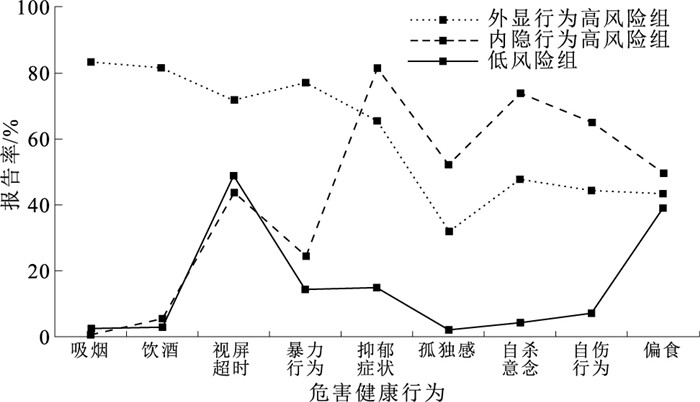Latent classes of health-risk behaviors and their association with school connectedness among adolescents in the Wuling Mountain Area
-
摘要:
目的 了解武陵山区青少年危害健康行为潜在类别及其与学校联结的关联,为制定分类高效干预措施提供参考。 方法 于2023年3—6月,运用多阶段分层整群随机抽样法抽取武陵山区8所学校的3 386名初、高中学生为调查对象,采用基本信息问卷、危害健康行为问卷、学校联结量表进行调查。采用潜在类别分析探究武陵山区青少年危害健康行为的潜在类别,运用无序多分类Logistic回归模型分析潜在类别与学校联结的关联。 结果 武陵山区青少年危害健康行为可分为外显行为高风险组(5.64%)、内隐行为高风险组(26.90%)、低风险组(67.45%)3个潜在类别;不同性别、民族、家庭类型的青少年在外显行为高风险组、内隐行为高风险组和低风险组3个潜在类别组的分布差异均有统计学意义(χ2值分别为117.91,22.55,21.51,P值均 < 0.05);无序多分类Logistic回归模型分析结果显示,以低风险组为参照,学校联结得分高与外显行为高风险组(OR=0.89,95%CI=0.88~0.91)和内隐行为高风险组(OR=0.90,95%CI=0.89~0.91)均呈负相关(P值均 < 0.05)。 结论 武陵山区青少年危害健康行为类别特征明显,外显行为高风险组、内隐行为高风险组均与学校联结存在负向关联。应积极采取相应措施,提高青少年学校归属感,降低危害健康行为的聚集共存状况。 Abstract:Objective To understand the potential categories of health-risk behaviors among adolescents in the Wuling Mountain Area and their association with school connectedness, so as to provide reference for formulating classified and effective intervention measures. Methods From March to June 2023, 3 386 middle and high school students from eight schools in the Wuling Mountain Area were selected using the multistage stratified cluster random sampling method. A basic information questionnaire, health-risk behaviors questionnaire, and school connectedness scale were utilized for the survey. The latent classes of adolescent health-risk behaviors in the Wuling Mountain Area were investigated by using latent class analysis, while an multinomial Logistic regression model was employed to analyze the association between latent classes and school connectedness. Results Adolescent health-risk behaviors in the Wuling Mountains Area were classified into three latent classes: high-risk class of episodic behaviors (5.64%), high-risk class of implicit behaviors (26.90%), and low-risk class of implicit behaviors (67.45%). Gender, ethnicity, and family type revealed significant differences in the distribution of the three latent classes (χ2=117.91, 22.55, 21.51, P < 0.05). The results of the regression model analysis showed that, with the low-risk class as the reference category, high school connectedness scores were associated with the high-risk class of episodic behaviors (OR=0.89, 95%CI=0.88-0.91) and the high-risk class of implicit behaviors (OR=0.90, 95%CI=0.89-0.91)(P < 0.05). Conclusions The characteristics of adolescent health-risk behavior classes in the Wuling Mountain Area are obvious. The high-risk class of episodic behaviors and the high-risk class of implicit behaviors are negatively correlated with school connectedness. Corresponding measures should be taken to enhance adolescents' sense of belonging in school and reduce the aggregation and co-occurrence of health-risk behaviors. -
Key words:
- Dangerous behaivor /
- School connections /
- Regression analysis /
- Adolescent
1) 利益冲突声明 所有作者声明无利益冲突。 -
表 1 武陵山区青少年危害健康行为潜类别模型1~5类拟合指标(n=3 386)
Table 1. Fitting indicators of Category 1 to 5 of the latent category model of health-risk behaviors among adolescents in Wuling Mountain Area(n=3 386)
模型 参数条目 AIC值 BIC值 aBIC值 Entropy值 PLMR值 PBLRT值 类别概率 1 9 31 585.13 31 640.27 31 611.68 1.00 1.00 2 19 29 418.83 29 535.25 29 474.88 0.75 < 0.01 < 0.01 0.31/0.69 3 29 29 008.72 29 186.42 29 094.27 0.83 < 0.01 < 0.01 0.06/0.27/0.68 4 39 28 822.56 29 061.52 28 937.60 0.77 0.14 < 0.01 0.65/0.05/0.04/0.26 5 49 28 679.41 28 979.65 28 823.96 0.66 0.01 < 0.01 0.58/0.16/0.04/0.05/0.17 表 2 武陵山区不同人口学特征青少年危害健康行为潜在类别组分布比较
Table 2. Comparison of distribution of the potential categories of health-risk behaviors among adolescents with different characteristics in Wuling Mountain Area
人口学指标 选项 人数 外显行为高风险组 内隐行为高风险组 低风险组 χ2值 P值 性别 男 1 760 146(8.30) 354(20.11) 1 260(71.59) 117.91 < 0.01 女 1 626 45(2.77) 557(34.26) 1 024(62.98) 学段 初中 1 656 83(5.01) 448(27.05) 1 125(67.93) 2.41 0.30 高中 1 730 108(6.24) 463(26.76) 1 159(66.99) 民族 汉族 641 30(4.68) 183(28.55) 428(66.77) 22.55 0.01 土家族 2 293 137(5.97) 583(25.43) 1 573(68.60) 苗族 404 17(4.21) 131(32.43) 256(63.36) 侗族 14 2(14.29) 4(28.57) 8(57.14) 其他民族 34 5(14.71) 10(29.41) 19(55.88) 城乡 农村 719 42(5.84) 218(30.32) 459(63.84) 5.79 0.06 城市 2 667 149(5.59) 693(25.98) 1 825(68.43) 独生子女 是 565 35(6.19) 161(28.50) 369(65.31) 1.47 0.48 否 2 821 156(5.53) 750(26.59) 1 915(67.88) 住校 是 2 973 166(5.58) 793(26.67) 2 014(67.74) 0.93 0.63 否 413 25(6.05) 118(28.57) 270(65.38) 留守 是 746 50(6.70) 212(28.42) 484(64.88) 3.67 0.16 否 2 640 141(5.34) 699(26.48) 1 800(68.18) 父亲学历 小学及以下 676 34(5.03) 199(29.44) 443(65.53) 8.70 0.19 初中 1 636 95(5.81) 421(25.73) 1 120(68.46) 高中 728 37(5.08) 187(25.69) 504(69.23) 大学及以上 346 25(7.23) 104(30.06) 217(62.72) 母亲学历 小学及以下 1 114 61(5.48) 327(29.35) 726(65.17) 12.09 0.06 初中 1 421 82(5.77) 348(24.49) 991(69.74) 高中 589 28(4.75) 158(26.83) 403(68.42) 大学及以上 262 20(7.63) 78(29.77) 164(62.60) 家庭类型 核心家庭 1 944 112(5.76) 496(25.51) 1 336(68.72) 21.51 0.01 三代同堂 866 48(5.54) 217(25.06) 601(69.40) 单亲家庭 246 13(5.28) 90(36.59) 143(58.13) 重组家庭 215 13(6.05) 69(32.09) 133(61.86) 其他家庭 115 5(4.35) 39(33.91) 71(61.74) 注:()内数字为构成比/%;核心家庭指子女与父母一起生活的家庭,其他家庭主要包括隔代家庭、亲戚朋友为监护人的家庭。 -
[1] 季成叶. 青少年健康危险行为监测: 学校卫生工作的重要前沿[J]. 中国学校卫生, 2009, 30(2): 99-105. https://xueshu.baidu.com/usercenter/paper/show?paperid=982158ff8e7f53ba32b47d28d5f1782b&site=xueshu_seJI C Y. Surveillance of adolescent health risk behaviors: an important frontier for school health[J]. Chin J Sch Health, 2009, 30(2): 99-105. (in Chinese) https://xueshu.baidu.com/usercenter/paper/show?paperid=982158ff8e7f53ba32b47d28d5f1782b&site=xueshu_se [2] MA J, BETTS N M, HAMPL J S. Clustering of lifestyle behaviors: the relationship between cigarette smoking, alcohol consumption, and dietary intake[J]. Am J Health Promot, 2000, 15(2): 107-117. doi: 10.4278/0890-1171-15.2.107 [3] CHIOLERO A, WIETLISBACH V, RUFFIEUX C, et al. Clustering of risk behaviors with cigarette consumption: a population-based survey[J]. Prev Med, 2006, 42(5): 348-353. doi: 10.1016/j.ypmed.2006.01.011 [4] 邱皓政. 潜在类别模型的原理与技术[M]. 北京: 教育科学出版社, 2008: 42.QIU H Z. Principles and techniques of potential category modeling[M]. Beijing: Education Science Press, 2008: 42. (in Chinese) [5] 庄绪秀, 刘洋, 王一诺, 等. 儿童青少年肥胖相关健康危险行为共存及模式研究进展[J]. 中国学校卫生, 2021, 42(12): 1917-1920. doi: 10.16835/j.cnki.1000-9817.2021.12.038ZHUANG X X, LIU Y, WANG Y N, et al. Research update on the co-occurrence and clustering model of obesity-related health risky behaviors in children and adolescents[J]. Chin J Sch Health, 2021, 42(12): 1917-1920. (in Chinese) doi: 10.16835/j.cnki.1000-9817.2021.12.038 [6] 殷颢文, 贾林祥. 学校联结的研究现状与发展趋势[J]. 心理科学, 2014, 37(5): 1180-1184. https://www.cnki.com.cn/Article/CJFDTOTAL-XLKX201405026.htmYIN H W, JIA L X. The research situation and development tendency of school bonding[J]. J Psychol Sci, 2014, 37(5): 1180-1184. (in Chinese) https://www.cnki.com.cn/Article/CJFDTOTAL-XLKX201405026.htm [7] 喻承甫, 张卫, 曾毅茵, 等. 青少年感恩与问题行为的关系: 学校联结的中介作用[J]. 心理发展与教育, 2011, 27(4): 425-433. https://www.cnki.com.cn/Article/CJFDTOTAL-XLFZ201104014.htmYU C F, ZHANG W, ZENG Y Y, et al. Relationship between adolescents' gratitude and problem behavior: the mediating role of school connectedness[J]. Psychol Dev Educ, 2011, 27(4): 425-433. (in Chinese) https://www.cnki.com.cn/Article/CJFDTOTAL-XLFZ201104014.htm [8] 洪新伟, 苗灵童, 范航, 等. 父母婚姻冲突与青少年攻击行为的关系: 情绪安全感和学校联结的作用[J]. 心理发展与教育, 2023, 39(5): 726-734. https://www.cnki.com.cn/Article/CJFDTOTAL-XLFZ202305014.htmHONG X W, MIAO L T, FAN H, et al. The relationship between parental conflict and adolescents, aggressive behavior: roles of emotional security and school connectedness[J]. Psychol Dev Educ, 2023, 39(5): 726-734. (in Chinese) https://www.cnki.com.cn/Article/CJFDTOTAL-XLFZ202305014.htm [9] 王建平, 陈雨漩, 甄霜菊. 学校联结与青少年非自杀性自伤: 心理需求满足同伴侵害的作用[J]. 中国青年社会科学, 2021, 40(5): 76-87. https://www.cnki.com.cn/Article/CJFDTOTAL-ZQNZ202105013.htmWANG J P, CHEN Y X, ZHEN S J. School bonding and non-suicidal self-injury in adolescents: the role of psychological need fulfillment and peer victimization[J]. J Chin Youth Soc Sci, 2021, 40(5): 76-87. (in Chinese) https://www.cnki.com.cn/Article/CJFDTOTAL-ZQNZ202105013.htm [10] 季成叶. 中国青少年健康相关/危险行为调查综合报告2005[M]. 北京: 北京大学医学出版社, 2007: 38-43, 322-327.JI C Y. Investigation report on health risk behaviors of urban adolescents in China(2005)[M]. Beijing: Peking University Press, 2007: 38-43, 322-327. (in Chinese) [11] 殷颢文, 贾林祥, 孙配贞. 学校联结在青少年感恩与社会适应间的作用[J]. 中国学校卫生, 2019, 40(1): 69-71, 75. doi: 10.16835/j.cnki.1000-9817.2019.01.018YIN H W, JIA L X, SUN P Z. Mediating role of school bonding in the association between adolescent gratitude and social adaptation[J]. Chin J Sch Health, 2019, 40(1): 69-71, 75. (in Chinese) doi: 10.16835/j.cnki.1000-9817.2019.01.018 [12] 董宝林, 张欢, 朱乐青, 等. 女大学生体育锻炼行为机制研究[J]. 南京体育学院学报(社会科学版), 2013, 27(6): 91-98. https://www.cnki.com.cn/Article/CJFDTOTAL-LJTB201306018.htmDONG B L, ZHANG H, ZHU L Q, et al. Research on the mechanism of female students' physical exercise behavior[J]. Nanjing Inst Phys Educ(Soc Sci Edit), 2013, 27(6): 91-98. (in Chinese) https://www.cnki.com.cn/Article/CJFDTOTAL-LJTB201306018.htm [13] 缪学超. 程序教学法的形成、要义、实验及当代价值[J]. 课程教材教法, 2015, 35(7): 101-107. https://www.cnki.com.cn/Article/CJFDTOTAL-KJJF201507017.htmMIAO X C. Formation, essence, experiment and contemporary value of programmed instruction method[J]. Curr Teach Mater Method, 2015, 35(7): 101-107. (in Chinese) https://www.cnki.com.cn/Article/CJFDTOTAL-KJJF201507017.htm [14] 张云婷, 马生霞, 陈畅, 等. 中国儿童青少年身体活动指南[J]. 中国循证儿科杂志, 2017, 12(6): 401-409. https://www.cnki.com.cn/Article/CJFDTOTAL-XZEK201706001.htmZHANG Y T, MA S X, CHEN C, et al. Physical activity guide for Chinese children and adolescents[J]. Chin J Evid Based Pediatr, 2017, 12(6): 401-409. (in Chinese) https://www.cnki.com.cn/Article/CJFDTOTAL-XZEK201706001.htm [15] 王孟成, 邓俏文, 毕向阳, 等. 分类精确性指数Entropy在潜剖面分析中的表现: 一项蒙特卡罗模拟研究[J]. 心理学报, 2017, 49(11): 1473-1482. https://www.cnki.com.cn/Article/CJFDTOTAL-XLXB201711011.htmWANG M C, DENG Q W, BI X Y, et al. Performance of the entropy as an index of classification accuracy in latent profileanalysis: a Monte Carlo simulation study[J]. Acta Psychol Sinca, 2017, 49(11): 1473-1482. (in Chinese) https://www.cnki.com.cn/Article/CJFDTOTAL-XLXB201711011.htm [16] 潘文浩, 赵守盈, 黄明明, 等. 新入职幼儿教师心理弹性潜类别及其与职业适应的关系[J]. 中国心理卫生杂志, 2021, 35(3): 213-219. https://www.cnki.com.cn/Article/CJFDTOTAL-ZXWS202103007.htmPAN W H, ZHAO S Y, HUANG M M, et al. Latent classes of psychological resilience and its relationship with occupational adaptation in novice preschool teachers[J]. Chin Ment Health J, 2021, 35(3): 213-219. (in Chinese) https://www.cnki.com.cn/Article/CJFDTOTAL-ZXWS202103007.htm [17] 徐涛, 余静, 雷丽, 等. 贵州省农村初中生健康危险行为潜类别及与自我控制的关系[J]. 卫生研究, 2023, 52(6): 950-955. https://www.cnki.com.cn/Article/CJFDTOTAL-WSYJ202306013.htmXU T, YU J, LEI L, et al. Latent classes of health risk behaviors and their relationship with self-control among rural secondary school students in Guizhou Province[J]. J Hyg Res, 2023, 52(6): 950-955. (in Chinese) https://www.cnki.com.cn/Article/CJFDTOTAL-WSYJ202306013.htm [18] 吉园依, 徐寰宇, 张宇, 等. 四川省农村留守儿童健康危险行为潜类别分析[J]. 中国公共卫生, 2017, 33(9): 1297-1301. https://www.cnki.com.cn/Article/CJFDTOTAL-ZGGW201709002.htmJI Y Y, XU H Y, ZHANG Y, et al. Health risk behaviors among rural left-behind children in Sichuan Province: a latent class analysis[J]. Chin J Public Health, 2017, 33(9): 1297-1301. (in Chinese) https://www.cnki.com.cn/Article/CJFDTOTAL-ZGGW201709002.htm [19] 何二林, 叶晓梅, 毛亚庆. 学校氛围对留守儿童校园欺凌的影响机制研究[J]. 教育学报, 2022, 18(3): 144-158. https://www.cnki.com.cn/Article/CJFDTOTAL-XKJY202203013.htmHE E L, YE X M, MAO Y Q. The effect mechanism of school climate on school bullying among left-behind children[J]. J Educ Stud, 2022, 18(3): 144-158. (in Chinese) https://www.cnki.com.cn/Article/CJFDTOTAL-XKJY202203013.htm [20] 曹志成, 王戈, 张澜. 父母教养方式及主观幸福感对初中生健康危害行为影响[J]. 中国公共卫生, 2019, 35(12): 1666-1670. https://www.cnki.com.cn/Article/CJFDTOTAL-ZGGW201912018.htmCAO Z C, WANG G, ZHANG L. Influence of parenting style and subjective well-being on health risk behaviors among junior high school students[J]. Chin J Public Health, 2019, 35(12): 1666-1670. (in Chinese) https://www.cnki.com.cn/Article/CJFDTOTAL-ZGGW201912018.htm [21] 关汝珊, 赖雪芬. 梅州市青少年心理资本亲子依恋与外化问题行为的关系[J]. 中国学校卫生, 2019, 40(11): 1731-1733. doi: 10.16835/j.cnki.1000-9817.2019.11.038GUAN R S, LAI X F. The relationship between parent-child attachment and externalized problem behavior of adolescent psychological capital in Meizhou City[J]. Chin J Sch Health, 2019, 40(11): 1731-1733. (in Chinese) doi: 10.16835/j.cnki.1000-9817.2019.11.038 [22] 杨逸群, 陈亮, 陈光辉, 等. 同伴拒绝友谊支持对青少年抑郁的影响: 有中介的调节模型[J]. 中国临床心理学杂志, 2020, 28(2): 348-353.YANG Y Q, CHEN L, CHEN G H, et al. Peer rejection, friendship support and adolescent depressive symptoms: a mediated moderation model[J]. Chin J Clin Psychol, 2020, 28(2): 348-353. (in Chinese) [23] 孟思佳. 青少年领悟社会支持对问题性移动社交网络使用的影响[D]. 哈尔滨: 哈尔滨师范大学, 2020.MENG S J. The impact of adolescents' perceived social support on the use of problem mobile social networks: the mediating effect of loneliness and negative coping styles[D]. Harbin: Harbin Normal University, 2020. (in Chinese) [24] 姚文玉, 张雯, 刘影, 等. 儿童抑郁水平与学业成绩的发展轨迹: 基于平行潜变量增长模型[J]. 心理与行为研究, 2021, 19(2): 223-229. https://www.cnki.com.cn/Article/CJFDTOTAL-CLXW202102012.htmYAO W Y, ZHANG W, LIU Y, et al. Developmental trajectories of depression and academic achievement in children: based on parallel latent growth modeling[J]. Stud Psychol Behav, 2021, 19(2): 223-229. (in Chinese) https://www.cnki.com.cn/Article/CJFDTOTAL-CLXW202102012.htm -







 下载:
下载:

